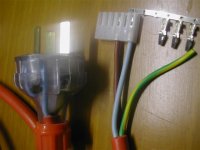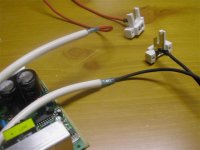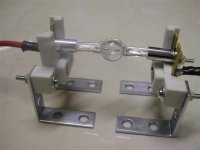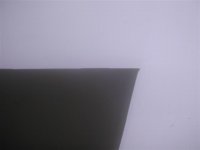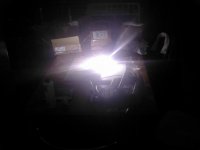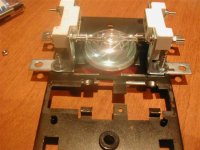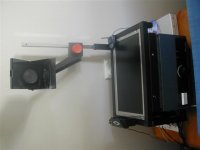input power: 3 pin connector
pin numbering: pin 1 closest to corner of PCB
pin 1: earth not connected
pin 2: active - brown wire from extension lead. fuse is connected to it.
pin 3: neutral - blue wire from extension.
Cut up a spare extension lead and added a 6 hole connector from jaycar that has the same spacing but I'm only using 2 of the connectors. Filed down a plastic catch on the 6 hole connector so it would fit properly.
It looks like 2 wires have been previously soldered to the bottom of my PCB for power input, so you could do the same but I wanted a more flexible approach. I wonder if my ballast used or just tested?
pin numbering: pin 1 closest to corner of PCB
pin 1: earth not connected
pin 2: active - brown wire from extension lead. fuse is connected to it.
pin 3: neutral - blue wire from extension.
Cut up a spare extension lead and added a 6 hole connector from jaycar that has the same spacing but I'm only using 2 of the connectors. Filed down a plastic catch on the 6 hole connector so it would fit properly.
It looks like 2 wires have been previously soldered to the bottom of my PCB for power input, so you could do the same but I wanted a more flexible approach. I wonder if my ballast used or just tested?
Attachments
ywh has soldered a short circuit on a black component next to the small four pin connector. This causes the ballast to turn on as soon as power is applied to it, so no need to add a switch or short circuit it yourself.
The ballast does require active cooling or it shuts off. I know, I thought something had broken when it did it. I have since put a fan on it and had it running for several hours.
A friend of mine, who is a high voltage electrician and works for a local power company, helped me with my wiring.
He also took some measurements.
248.4 volts at the power point.
0.74 amps at the active line into the ballast.
So using P=VI we get P = 248.4V X 0.74A = 183.816W
This seems to suggest that the PMA161X is more like a 155W ballast (Similar to the PMA161A shown at http://www1.ushio.co.jp/catalog/100e/1035.html )
I may have to get one of 250W ballast that ywh originally found (200v only) in order to verify it.
I'm looking forward to putting it into my gutted ohp and lighting up my SGI 1600sw panel. I am currently only using a HQI-T 150W 8mm arc.
I'll try and do some comparisons.
I also have a dukane 670 with a HMI 575W which I might put it up against.
more to come... better start my own thread.
pic: a small sun on my table..
The ballast does require active cooling or it shuts off. I know, I thought something had broken when it did it. I have since put a fan on it and had it running for several hours.
A friend of mine, who is a high voltage electrician and works for a local power company, helped me with my wiring.
He also took some measurements.
248.4 volts at the power point.
0.74 amps at the active line into the ballast.
So using P=VI we get P = 248.4V X 0.74A = 183.816W
This seems to suggest that the PMA161X is more like a 155W ballast (Similar to the PMA161A shown at http://www1.ushio.co.jp/catalog/100e/1035.html )
I may have to get one of 250W ballast that ywh originally found (200v only) in order to verify it.
I'm looking forward to putting it into my gutted ohp and lighting up my SGI 1600sw panel. I am currently only using a HQI-T 150W 8mm arc.
I'll try and do some comparisons.
I also have a dukane 670 with a HMI 575W which I might put it up against.
more to come... better start my own thread.
pic: a small sun on my table..
Attachments
prime, thanks for the info. It is very helpful for others.
YWH is out of town right now. Before he left his computer, he send me a massage about where to input the power. but seems you have figured that out already.
do you think the bulb is actually running at 150W? I will receive both 150w and 250w bulb and the same ballast you have. at that time I will see if 250w is the same brightness as 150w, and if 250w is running at 150w only.
YWH is out of town right now. Before he left his computer, he send me a massage about where to input the power. but seems you have figured that out already.
do you think the bulb is actually running at 150W? I will receive both 150w and 250w bulb and the same ballast you have. at that time I will see if 250w is the same brightness as 150w, and if 250w is running at 150w only.
to 18wheeler I am waiting for some info from YWH but I thougt of another question I an earler post on this thread there are some pictures of your lamps is the 150w lamp the same shape as the 120W shown with a screw terminal at one end and a wire at the other cos that is what i need
thanks
thanks
248.4 volts at the power point.
0.74 amps at the active line into the ballast.
So using P=VI we get P = 248.4V X 0.74A = 183.816W
This assumes that the power supply is operating at a power factor of 1, which it probably is not. You really have to look at the phase shift between the current and voltage waveforms to get an accurate measurement of apparent power (in VA). An easier way to do it would be to measure power on the lamp leads since the lamp is purely resistive and will therefore operate at a unity power factor.
Thanks for the reply and updates as far as progress. It does sound like the 250W bulb is working as a 150W which may or may not be benifical in terms of life. I'll be interested to see comparison with other bulbs to see how the brightness compares as thats what really matters at the end of the day. It may be a better path for those of us in the USA to get the first ballast that is designed for 220V and use a 110V to 220V converter so that we can drive the bulb at full power. There seem to be quite a few 110V to 220V converters for around $30 with a 300W rating.
I'm less worried about the ballast, as I assume one way or another we can get the ballast working, especially if it is DC and the bulb lights on a 150W ballast all we need to do is up the current, but finding a source for short arc bulbs with a good colour temp, good life and reasonable cost has been the big problem.
I'm less worried about the ballast, as I assume one way or another we can get the ballast working, especially if it is DC and the bulb lights on a 150W ballast all we need to do is up the current, but finding a source for short arc bulbs with a good colour temp, good life and reasonable cost has been the big problem.
I think ywh has said he didn't notice brightness difference between the same lamp with these two ballasts. so the original 220V ballast may or may not actually work in full power.
YWH also mentioned at different place that this lamp "could" work with other electronic ballasts. If some one can loan me a 250W HQI ballast, I will try the lamp on and see if it gives more light.
YWH also mentioned at different place that this lamp "could" work with other electronic ballasts. If some one can loan me a 250W HQI ballast, I will try the lamp on and see if it gives more light.
Pagercam said:Thanks for the reply and updates as far as progress. It does sound like the 250W bulb is working as a 150W which may or may not be benifical in terms of life.
YWH has said he got conflict statements about the lamps' life. could it is because a ballast with different power rate was used to do real test?
Prime (or anybody who has this ballast), can you take a current/voltage measurement at the lamp terminals so that we can see exactly how much DC power the lamp is receiving? Be sure to hook the volt meter up after the lamp has warmed up because most voltmeters won't like that 14 kV ignition spike 
I agree that the bulb is the main interest here... if these things work well in commercial DLP/LCD projectors then the biggest drawback of commercial is gone, IMO. If those graphs posted above are correct, these bulbs should last 6000+ hours at DC, though they probably tested it for 6000 hours straight without thermal cycling or reignition, which are probably significant mortality factors That is over 5 years of use at 3 hours a day, but even if it's only a third of that then the investment is still tiny compared to the normal replacement bulb. Has anybody tested a commercial unit to see if it's AC or DC?
That is over 5 years of use at 3 hours a day, but even if it's only a third of that then the investment is still tiny compared to the normal replacement bulb. Has anybody tested a commercial unit to see if it's AC or DC?

I agree that the bulb is the main interest here... if these things work well in commercial DLP/LCD projectors then the biggest drawback of commercial is gone, IMO. If those graphs posted above are correct, these bulbs should last 6000+ hours at DC, though they probably tested it for 6000 hours straight without thermal cycling or reignition, which are probably significant mortality factors
Waiting until the bulb is lit is OK for measuring voltage but you need the meter inline to measure current. So I'm not sure how this could be measured with a common multimeter.
By the way that 14K that you found was for another type of bulb, MH literature that I've seen generally specifies ignition voltages of 2-6KV which will probably still be a problem for garden variety MMs, although I assume that these are short spikes like a photo flash so the short duration might be tolerated, but yet again another issue to be over come.
I'm guessing that power factor shouldn't be that much of an issue, I'm not that knowledgable about power electronics but wouldn't the current be higher if the curent peak doesn't line up with the voltage peak? So wouldn't you get reading off high rather than low if power factor was the issue??? A well designed power supply should have a power factor close to 1 and I've got to assume that Ushio knows how to do this. So while current in the AC input may not be perfect it should be pretty close. Most of the AC output ballasts take 450W to drive a 400W bulb so I would expect 15% inefficencies and more to account for the AC/DC conversion so 183 watts for a ballast designed for 160W is pretty efficient, I would expect ~300W to drive a 250W bulb and power eaten up in the ballast. The fact that the ballast is overheating and requires a fan suggests that a good amount of power is used up in the ballast itself. 183Watts is probably a bit low if anything but well below what I would expect for AC/DC and a 250W bulb.
It would be interesting to put a 150W bulb on the ballast and see what the power draw is then. Prime showed quite a few bulbs in his first delivery post are any of those 150W bulbs???
By the way that 14K that you found was for another type of bulb, MH literature that I've seen generally specifies ignition voltages of 2-6KV which will probably still be a problem for garden variety MMs, although I assume that these are short spikes like a photo flash so the short duration might be tolerated, but yet again another issue to be over come.
I'm guessing that power factor shouldn't be that much of an issue, I'm not that knowledgable about power electronics but wouldn't the current be higher if the curent peak doesn't line up with the voltage peak? So wouldn't you get reading off high rather than low if power factor was the issue??? A well designed power supply should have a power factor close to 1 and I've got to assume that Ushio knows how to do this. So while current in the AC input may not be perfect it should be pretty close. Most of the AC output ballasts take 450W to drive a 400W bulb so I would expect 15% inefficencies and more to account for the AC/DC conversion so 183 watts for a ballast designed for 160W is pretty efficient, I would expect ~300W to drive a 250W bulb and power eaten up in the ballast. The fact that the ballast is overheating and requires a fan suggests that a good amount of power is used up in the ballast itself. 183Watts is probably a bit low if anything but well below what I would expect for AC/DC and a 250W bulb.
It would be interesting to put a 150W bulb on the ballast and see what the power draw is then. Prime showed quite a few bulbs in his first delivery post are any of those 150W bulbs???
rth said:Has anybody tested a commercial unit to see if it's AC or DC?
i checked the voltage across the lamp of a 120wUHP for DL 500 DLP and it is 100 volts AC.
the ballast is similar to the one posted by YWH
http://www.diyaudio.com/forums/showthread.php?postid=678838#post678838
http://www.diyaudio.com/forums/showthread.php?postid=680228#post680228
Pagercam said:Waiting until the bulb is lit is OK for measuring voltage but you need the meter inline to measure current. So I'm not sure how this could be measured with a common multimeter.
I asked my friend and he remembered he's got something in his van to measure the inline dc current. stay tuned..
Pagercam said:By the way that 14K that you found was for another type of bulb,
There is a warning on the ballast of 15K voltage when starting up. and not to touch it for at least 3 mins after power off.


Pagercam said:It would be interesting to put a 150W bulb on the ballast and see what the power draw is then. Prime showed quite a few bulbs in his first delivery post are any of those 150W bulbs???
I already had those other lamps. They were for size reference.
I have 3 x 150W MH lamps (currently happily using one in ohp). I could risk one of them but I thought they needed AC power. I also have a 150W eballast. I don't know if it is AC or DC, I'll have to check with the supplier on Monday.
The PMA161X ballast makes the same humming noise as my 150W eballast. I cold try one of the new 250W lamps on the 150W ballast and see what happens.
BTW. I put the new kit in my ohp and had a very short look, no time for adjustment. Colour was better than my 4200K, 150W lamp but brightness was about the same. A little disappointed.
The holders are mounted upside down in the following pic so I could get the right height above the relector.
Attachments
prime said:
I asked my friend and he remembered he's got something in his van to measure the inline dc current. stay tuned..
There is a warning on the ballast of 15K voltage when starting up. and not to touch it for at least 3 mins after power off.
voltage can be measured after lamp was turned on (after 15KV has started the lamp). so there is no problem.
I have an idea how to measure the current on the lamp:
put a switch inline with lamp, turn on the lamp; wait for a few minutes, then connect meter to ends of the switch. make sure it is properly connected, flip the switch off. now all current should go through the meter, and you can get the reading.
- Status
- This old topic is closed. If you want to reopen this topic, contact a moderator using the "Report Post" button.
- Home
- General Interest
- Everything Else
- The Moving Image
- DIY Projectors
- I got my new lamp. It is for commercial projection use. people use it to replace the
